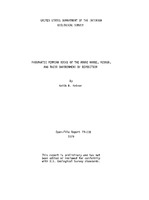Permian sedimentary rocks in the Adobe range, northern Nevada, are phosphatic, and although the particles of phosphate are relatively more disseminated, they closely resemble the rocks of the Phosphoria Formation. In the northern Adobe Range, where the entire Permian sequence is approximately correlative with the Phosphoria Formation, it is 200 m thick and averages 1.7 percent P2O5 . In the southern Adobe Range, the Permian sequence is more than 1,700 m thick, and the upper half which is roughly correlative with the Phosphoria Formation averages more than 2 percent P2O5. Some thin beds in rocks of Permian age contain more than 20 percent P2O5.
Phosphatic rocks of the Adobe Range were deposited in shallow water among islands in the western part of the epicontinental Phosphoria sea. The continental margin and the open ocean lay far to the west. At the same time, the Phosphoria Formation was being deposited in the eastern and central parts of the Phosphoria sea. Theories based on the work of Kasakov done in 1937 relating phosphate deposition directly to sites of upwelling oceanic waters are questioned. Nondeposition of diluent materials such as detritus and carbonate is probably of more importance in producing phosphate in economic concentrations than is geographic position with respect to upwelling waters.


